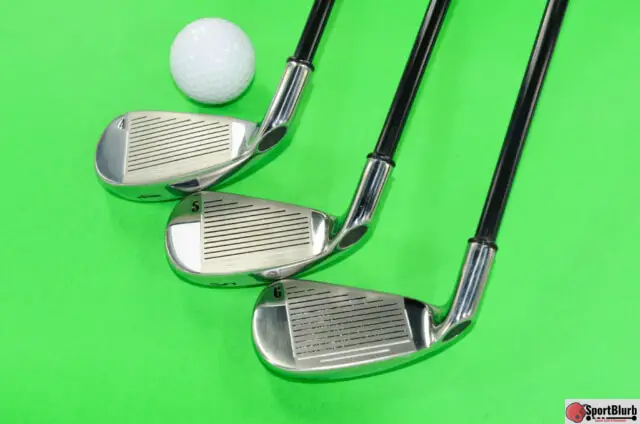Last Updated on October 8, 2023 by Alex PT
D4 and D2 swing weights differ by 2 grams. D4 clubs feel heavier and more stable, while D2 clubs feel lighter and more maneuverable. D4 clubs are better for golfers with faster swing speeds, while D2 clubs are better for golfers with slower swing speeds.
Differences Between The D4 & D2 Swing Weight
| Aspect | D4 Swing Weight | D2 Swing Weight |
|---|---|---|
| Weight Distribution | Heavier clubhead, CG towards the clubhead | Lighter clubhead, CG closer to the grip |
| Swing Feel | Provides more clubhead stability | Offers increased clubhead speed |
| Control | Better for golfers seeking control | Suits golfers looking for more distance |
| Shot Trajectory | Typically produces a lower ball flight | Tends to result in a higher ball flight |
| Shot Shape | May encourage straighter shots | Might lead to a slight draw or fade |
| Player Preference | Preferred by some advanced players | Often favored by beginners or seniors |
| Customization Options | Allows for fine-tuning with weights | Limited adjustments available |
| Suitable for… | Precision shots, irons, and wedges | Longer drives, woods, and hybrids |
Factors Affecting Swing Weight
Swing weight in golf is a measure of a club’s balance and how it feels during the swing. Several factors influence swing weight:
- Clubhead Weight: Heavier clubheads increase swing weight, providing more momentum in the swing. Lighter clubheads have the opposite effect.
- Shaft Weight: A heavier shaft can raise the swing weight, while a lighter shaft reduces it. The material and construction of the shaft also play a role.
- Grip Weight: Heavier grips add to the club’s overall weight and increase swing weight, whereas lighter grips have the opposite effect.
- Length of the Club: Longer clubs result in higher swing weights due to the added weight at the clubhead end. Shorter clubs decrease swing weight.
- Shaft Flex: Stiffer shafts can make the club feel slightly heavier during the swing, affecting the swing weight perception.
- Grip Style: The type of grip, including its size and material, can impact swing weight. Larger grips may add weight and increase swing weight.
- Additional Weighting: Some golfers add lead tape or weights to the clubhead or shaft to adjust swing weight to their preference.
- Balancing Point: The location of the club’s balance point or fulcrum affects swing weight. A balance point closer to the clubhead increases the swing weight.
- Customization: Manufacturers can customize clubs to achieve specific swing weight preferences for individual golfers.
- Player Preference: Personal preference and playing style play a significant role. Golfers may prefer a particular swing weight to achieve desired shot characteristics.
Swing Weight System

The weight of a swing scale was designed in 1920 by club expert Robert Adams, though some credit Kenneth Smith because he designed the fulcrum scale which is used to measure the swing weight. The swing scale though basically arbitrary has survived as the standard.
The swing height scale places clubs in classification with are designated by letters A through F. Each letter classification is then subdivided into tenths, starting at zero tenth through nine tenths. The numbers or letters that are greater than indicate the heavier club’s swing weight and so do the lesser numbers or letters.
Hence, the D1 swing weight is heavier than the C1 swing height. Club D4 has a slightly greater swing weight than Club D2. Standard typical men’s swing weight of about D0, while women have the standard swing weight of about C6.
Swing Weight Elements
The swing weight of any club is affected by its three main components which are; the shaft, the head, and the grip, the length of the shaft, and the balance point. A slight change in any of these five items will change the weight of the club’s swing.
Changing From D2 to D4
The easiest and quickest way to change a club’s swing weight is to add lead tape to the club’s head. Putting tape on the grip will reduce the weight of the swing. Just the right amount of increase or decrease will determine the club’s overall characteristics. If you hope to increase your D2 club weight to D4, it is a general rule to add four 2-inch-long strips of half-inch wide lead tape to the head of the club.
More so, to increase a swing weight of D2 to D4, add about 4 grams of weight to the head of the club, and remove 10 grams from the grip or shaft length by 1/3 inch. Though this method is a bit trickier but can also be done by increasing the swing weight by one unit for each 9 grams we add to the weight.
Matching Swing Weights
Expert club is of the opinion that swing weight should remain fairly constant throughout a golfer’s club sets, so their feel is uniform across the board. Other are of the opinion that the lowest swing should belong to the driver, and the wedges and short irons have slightly heavier swing weights.
Swing Weight In Golf Clubs
The swing weight of a club determines how heavy the club feels to the player swinging it. The weight of a swing relates to not only the weight of the club but importantly how the weight is being distributed.
A golf club that has more of its mass concentrated on the club’s head has a swing weight that is higher and demands more energy from players while swinging. For golfers to maximize their potential they must use the club that has the right swing weight.
Identification
In the 1920s, the manufacturer of clubs introduced swing weights as a way to ensure the unique and dynamic feel associated with the golf club.
Expressing Swing Weights

The weight of the swing uses a letter-and-number combination that represents the specific reading and range. There are six ranges, A through F, each has 10 values which are numbered 0 through 9.
F9 is the heaviest, and the lightest is the A0. The standard for most men’s clubs falls within the range of C9 through D8, D2 being the standard. The standard for most, women’s cubs falls within C4 through D0.
Frequently Asked Questions
What Is The Standard Male Swing Weight?
According to the American Golf Association, the standard for most men’s club fall within the range of C9 through D8, D2 being the standard.
What Is The Standard Female Swing Weight?
According to the American Golf Association, the standard for most women’s cubs falls within C4 through D0.
Can I Play Golf With Any Golf Swing?
Not! For optimal performance, you must select a club with a swing weight that supports/complements your strength and play styles.
Does a Golf Swing affect golfing performance?
It does. The swing weight has an impact on the force produced and the flight trajectory of the ball. Since most golfers aim for the ball to go farther, the right club is pivotal to archiving that
Which golf swing weight is perfect for me?
Finding the right club perfect for you is critical to optimal performance and deciding if it would be a D2, D4, or D0 is not a choice you’ll make vaguely but one factor such as your strength. Stronger players are advised to use the D4 whilst those not strong enough should use a lighter club.
Conclusion
Those clubs with higher swing weights should be used by stronger ones while clubs with lower values should be used by weaker players.
The right swing height is that which is light enough for the player to exact enough strength to translate into the right head speed, making the ball cover a great distance in flight but heavy enough to transfer enough energy to the ball and keep the club on track in the downswing.
References:
https://www.sportsrec.com/13732614/differences-between-d4-d2-swing-weight-20667html
https://thegolfmine.com/swing-weight-d1-d2-d3-d4/

Hi! I’m Alex PT. I hold a Bachelor’s degree in Sports Management from Indiana University and have over seven years of valuable experience working in a Sports Event Management Company. I founded SportBlurb with the passion for bringing you the latest, most insightful, and engaging content in the world of sports. So, whether you’re a die-hard fan or want to stay informed, I’ve got you covered!

